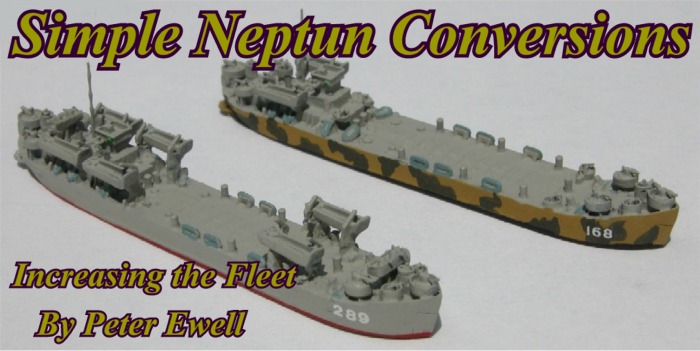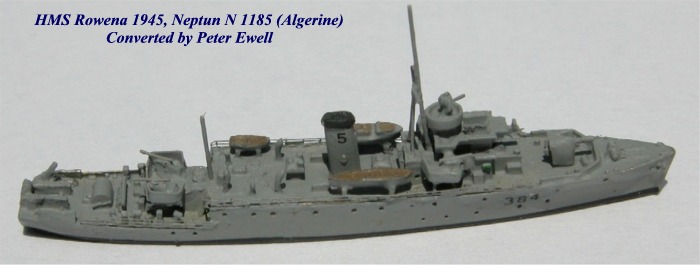 |
 |
Several years ago, just after this Board was established, I emailed Paul Jacobs a question that he has gotten many times before: "Does Neptun supply parts?" I also told him the background to my question: some conversion efforts that I had been undertaking using old Superior and Framburg models in an attempt to expand the number of destroyers and other small ships in my collection. Paul replied, "Well, if you're going to spend all that time working on a model why not work on a good one to begin with." This seemed very crazy to me at the time-CUT UP A NEPTUN??? But I decided to give it a try. Two straightforward techniques that I began with are "Simple Swaps" and "Adding Detail."
Simple Swaps -. Because Neptun does not supply parts, one way to generate new variants is to work with pairs of models that have the requisite parts to "swap." A good example is Neptun's LST 2 (N1389a), which is issued in a four-davit variant. Actually, there were far more two-davit and six-davit LSTs built than the 4-davit example that Neptun chose to model. So I decided to buy a couple of used LST models and move two sets of davits with their LCVPs from one to the other. My six-davit prototype (LST 289) also mounted extra 20mm, which I salvaged from my parts box.
I have since applied this basic idea to other pairs of models. For example, both Neptun versions of the Rudderow Class (N1353 and N1353a) carry quad-forties aft, although the first of the Rudderows built were equipped with twins. Similarly, both as-issued Neptun Cannon versions (N1352 and N1352a) carry twins in this position, while many were later enhanced to mount quads. Swapping these mounts provides two new models of each. Similarly, Neptun's standard Sumner (N1360) has two sets of tubes while Gearning (N1360a) has only one with an additional quad forty in place of the aft set. Swap the tubes for the AA mount and you have an early Gearing and a late-war Sumner.
The technique here is brute simple. Working with a very sharp hobby knife, gradually work the blade under the part in question and ease it off the deck below. The result may be some distortion in the part or mount, which you can then work to correct once it is severed. Sometimes you lose the tub, but tubs are easy to replace using plastic strip or sheet copper, which I find works better for irregular shapes. There will also be a small hole in the deck to be filled and sanded. This is not as much of a problem as you might think, because something else will almost always go in on top of the patch in any case. There is also the opportunity to add detail-small davits for DC throwers and boats can be a good enhancement. Masts are also sometimes worth replacing and, lately, photo-etch radar worth adding. Finally, painting and decaling numbers add a little to the finished product.
Adding Detai-. Another simple way to begin is to start with a relatively clean model like the Neptun unmodified USN Destroyers in pre-war rig and add additional equipment and features. This has the advantage of not having to carefully cut up the existing model to preserve the parts you need later. An early example for me was USS Conyngham in 1942. Here I started with Neptun's as-built model of Mahan (N1366). The first step was to cut away the massive tripod mast and forward searchlight, the number-three 5" mount, a pair of boats, and the searchlight platform aft of the second stack-as well as remove the twin 50 caliber mounts fore and aft. With everything filed clean, the objective was then to add scratch-built 20mm mounts as needed and some small finishing details. The 20mm tubs in the waist and forward on the aft deckhouse were fashioned from plastic drinking straws, while the mounts themselves are thin copper wire punched through card stock and cut to size. Additional 20mm were added side-by-side on top of the gun-crew shelter forward of the bridge in place of the twin 50 caliber mount, and two additional 20mm in super-firing positions on the aft deckhouse in place of the other twin 50. These required enclosure by light bulwarks, which were made from sheet copper. Finally, bulwarks in the waist were added back to the first set of tubes, made from sheet plastic with any gaps filled and sanded. A new pole foremast and some additional detail in the form of DC davits finished the model up.
Variations on a Theme - As my store of salvaged parts has grown through conversions, I have started working on new variations without having to follow the "Law of Conservation of Parts" entailed by the "swap" technique so strictly. A couple of these more recent conversions are illustrated:
USS Dunlap was one of two Mahans that carried her forward 5"/38s in enclosed mounts but otherwise differed little from their sisters. A standard Neptun modified Mahan (N1366a) thus worked fine for the basic model. The enclosed 5"/38 mounts came from Neptun's Barnegat (N1391), which I love to use as a parts source because these light seaplane tenders almost never actually carried the designed armament as portrayed by Neptun. N1366a as supplied is inaccurate in one detail for a late-war destroyer because it lacks the typical bulwarks in the waist, which I fashioned from sheet plastic, as I did with Conyngham. This model was also my first experience with the new Navalis photo-etch radars, which help a lot.
USS Engstrom required me to scratch-build a quad 1.1" mount, as carried by the first destroyers in 1943, in place of the twin-forty mount that comes on the standard Neptun Evarts (N1350). This mount was constructed rather like John Youngerman does it-create the base from plastic, put a bit of superglue on in and invert the base onto four carefully-laid out pieces of brass wire cut to size for the barrels, and finish with a strip of sheet plastic cross-wise across the back of the top of the mount.
USS Glennon was an attempt to do a square-bridge Benson, the simplified second-generation Benson design of the later war emergency program. This required starting with a standard Neptun Benson model (N1362a), which is already in the typical mid-war four-mount rig, removing the director, cutting down the bridge one level with a Dremel tool, filing the bridge front square, and rebuilding everything back with sheet plastic and copper. The 20mm mounted in a square tub just forward of the bridge on the centerline was another addition from the parts box, again originally from a Barnegat. She then received an extra pair of DCTs aft.
HMS Walker was my answer to Neptun's rather puzzling issue of multiple VW-Class destroyers in pre-war rig. I started with Neptun's model of Vivien (N1169a). The 12-pounder aft amidships was a re-work of one of the existing 4" mounts and the DCTs were scratch-built from plastic by first inserting a plastic rod in the deck, filing it down, then perching a slightly bigger piece of cut plastic rod to form the depth charge on top of it. The extra pair of 20mm in tubs amidships came from the parts box, actually, they were surplus to the LST "swap" described above.
HMS Havant was very similar in concept to HMS Walker, but required creating an angled bridge front for the standard Neptun G-H Class destroyer (N1368a) because these ex-Brazilian destroyers had this feature. This was modeled from a solid piece of lead and filed to shape. The DCTs were built in a similar fashion to Walker's.
Finally, HMS Rowena substituted scratch-built single Bofors mounts for the 20mms with which Neptun equipped its Algerine (N1185). The prototype also required changing the masts and searchlight platforms slightly from the supplied Neptun version. This was also was my first use of Tom's Modelworks brass rails.
 |
Undertaking these conversions is rewarding in several ways. First, you get to do the research. The task of finding just the right prototype to fit your available supply of parts and the right pictures to guide the finishing is great fun in itself. Second, they can really expand a collection, while illustrating the enormous variation that actually occurred across different members of a class. Finally, they are really not that hard if you limit the scope of the conversion and work slowly and carefully. Give it a try!